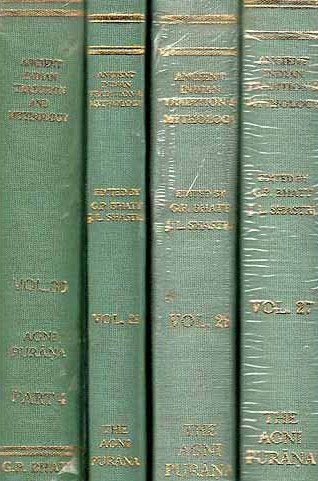The Agni Purana
by N. Gangadharan | 1954 | 360,691 words | ISBN-10: 8120803590 | ISBN-13: 9788120803596
This page describes Primary creation which is chapter 20 of the English translation of the Agni Purana, one of the eighteen major puranas dealing with all topics concerning ancient Indian culture, tradition and sciences. Containing roughly 15,000 Sanskrit metrical verses, subjects contained in the Agni-Purana include cosmology, philosophy, architecture, iconography, economics, diplomacy, pilgrimage guides, ancient geography, gemology, ayurveda, etc.
Chapter 20 - Primary creation
[Sanskrit text for this chapter is available]
Agni said:
1. The intellect (mahat) is the first creation of Brahmā. The second (creation) is that of the subtle principles (tanmātrās),[1] known as the bhūtasarga (creation of elements).
2. The third is the creation of evolutes (vaikārikas) known as the sense-organs. These are the primary creation (prākṛtasarga) produced out of the intellect.
3. The fourth, is the main creation (mukhyasarga). The immobile things are known as the main (creation). That (creation) which is spoken as (the creation of) the lower order (tiryaksrotas) is known as that of the sub-human beings (animals, birds etc.).
4. Then the sixth creation is that of the higher orders (ūrdhvasrotas), known as the creation of the celestials. Then the seventh creation is that of the middle orders (arvāksrotas), the man.
5-6. The eighth is the creation (known as) the anugraha (compassionate divinities), composed of the qualities (sāttvika and tāmasa. These (latter) five are known as the Vaikṛtasarga (creation subject to transformation). The ninth creation is the Kau-māra (the creation of Sanatkmāra etc.) These are the nine creations[2] of Brahmā which are the main cause for the universe.
7-8. Bhṛgu and others married Khyāti and other daughters of Dakṣa. Creation has been described as three-fold by the people. They are usual (nitya), subject to some cause (naimittika), (and) daily (dainandinī).[3] (The creation) after the intermediate dissolution is known as the daily (dainandinī). The constant creation that takes place everyday is considered as nitya.
9. From Bhṛgu, Khyāti gave birth to the celestials Dhātṛ and Vidhātṛ. Śrī (Lakṣmī) (was) the consort of Viṣṇu, and was praised by Śakra (Indra) for multiplying the progeny.
10. The sons of Dhātṛ and Vidhātṛ were Prāṇa and Mṛkaṇḍuka successively. Vedaśirā gave birth to Mārkaṇḍeya from Mṛkaṇḍu.
11-12. A son (by name) Paurṇamāsa was born to Marīci through Sambhūti. Sinīvālī, Kuhū, Rākā and Anumati were the sons of Aṅgiras through Smṛti. With Atri, Anasūyā gave birth to Soma, Durvāsas, and Dattātreya yogin.
13. A son (by name) Dattoli was born to Prīti, the wife of Pulastya. Sahiṣṇu and Kramapādika[4] were born to Kṣamā from Pulaha.
14. The highly radiant Bālakhilyas were born to Sannati[5] from Kratu. They, who were 60000, were of the size of a joint of the thumb.
15. To Urjā from Vasiṣṭha (were born) Raja, Gātra, Urdhvabāhu, Savana, Alaghu[6], Śukra and Sutapāḥ [=Sutapas?], the seven sages.
16. Pāvaka, Pavamāna and Śuci were born of Agni and. Svāhā. The manes Agniṣvāttāḥ [=Agniṣvāttas?]), devoid of fire and Barhiṣada, with fire (were born) from aja (Brahmā, the unborn).
17. Menā and Dhāriṇī were the daughters of the manes through Svadhā. Hiṃsā was the wife of Adharma. Then. Anṛta was born to them.
18. Nikṛti (was their) daughter. Bhaya and Naraka (were. born) from them, who had Māyā and Vedanā as their wives.
19. Of those two, Māyā gave birth to Mṛtyu, the destroyer of living beings. And also Vedanā gave birth to a son Duḥkha. from Raurava (Naraka).
20. Vyādhi, Jarā, Śoka, Tṛṣṇā and Krodha were born from Mṛtyu. (Rudra) was born wailing from Brahmā and (was known as) Rudra by name on account of the wailing.
21. O twice-born! the grandfather (Brahmā) said to (him) (called him as) Bhava, Śarva, Īśāna, Paśupati, Bhīma, Ugra (and) Mahādeva.
22. His wife Satī gave up her life on account of the wrath of Dakṣa and having become the daughter of Himavat again became the wife of Śambhu (Siva):
23. (I will now describe) the methods of worship of Viṣṇu etc., preceded by bathing and other (rites) and yielding enjoyment and emancipation, by doing which Svāyambhuva (Manu) (had the benefit), as told by Nārada and others to the sages.
Footnotes and references:
[1]:
The tanmātrās or the subtle principles are related to the sense-organs.
[2]:
The puranic cosmology divides creations into nine classes. See Śiva P, (English translation) p. 248 note 214.
